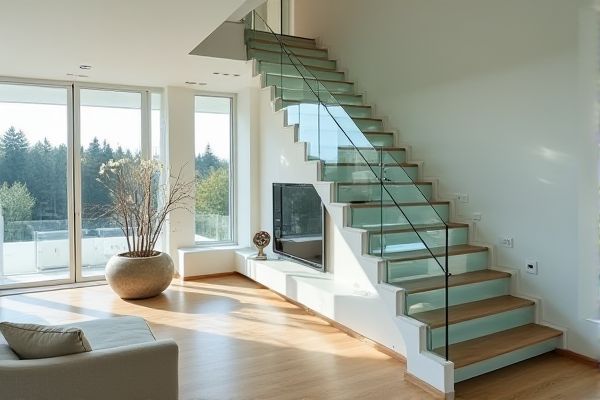
Curved glass railings offer a sleek, modern aesthetic with smooth, flowing lines that enhance architectural designs, while straight glass railings provide a classic, minimalist look with easier installation and cost efficiency. Explore the rest of the article to determine which glass railing style best suits your space and design preferences.
Table of Comparison
| Feature | Curved Glass Railing | Straight Glass Railing |
|---|---|---|
| Design | Elegant, flowing curves for modern aesthetics | Sleek, linear design for classic simplicity |
| Installation | Complex installation requiring skilled labor | Easy to install with standard procedures |
| Cost | Higher due to custom fabrication | More affordable with standardized panels |
| Material | Tempered or laminated curved glass panels | Tempered or laminated flat glass panels |
| Maintenance | Requires careful cleaning to maintain curve clarity | Simple maintenance with regular cleaning |
| Safety | Meets safety codes with proper framing | Meets safety codes and easy to inspect |
| Customization | Highly customizable shapes and radii | Limited to straight lines and angles |
| Applications | Ideal for stairs, balconies with circular designs | Suitable for decks, terraces, straightforward layouts |
Introduction to Glass Railings: Curved vs Straight
Curved glass railings create a seamless flow of elegance and sophistication, enhancing architectural designs with smooth, rounded edges ideal for modern staircases and balconies. Straight glass railings offer a classic, minimalist look with clean lines that maximize visibility and simplify installation, making them versatile for various residential and commercial applications. Both types utilize tempered or laminated glass to ensure safety and durability while providing unobstructed views and contemporary aesthetics.
Aesthetic Differences: Curved and Straight Glass Railings
Curved glass railings offer a sleek, flowing aesthetic that enhances architectural elegance by following natural or custom curves, creating a visually dynamic and soft appearance. Straight glass railings provide a clean, modern look characterized by sharp lines and uniformity, emphasizing simplicity and minimalism in design. Your choice between curved and straight glass railings significantly influences the overall style and atmosphere of a space, balancing between organic fluidity and structured precision.
Structural Integrity and Safety Considerations
Curved glass railings require specially tempered and laminated glass to maintain structural integrity due to the bending stresses involved, which enhances their ability to absorb impact and resist cracking. Straight glass railings typically use flat panels with standardized thickness, offering straightforward installation and consistent load-bearing capacity, making them highly reliable for safety compliance. Both types must meet stringent building codes and undergo rigorous testing to ensure they provide adequate fall protection, but curved designs often demand more precise engineering to address complex load distributions.
Design Flexibility and Customization Options
Curved glass railings offer superior design flexibility by seamlessly integrating with architectural features and enhancing aesthetic flow, ideal for spaces requiring organic or dynamic shapes. Straight glass railings provide a more straightforward, modular approach that simplifies installation and maintenance while offering customizable panel sizes and hardware finishes. Both options can be tailored to specific safety standards and style preferences, but curved designs allow for more creative expression in contemporary or complex layouts.
Installation Process: What to Expect
Curved glass railing installation requires precise measurements and custom-fabricated panels to fit the unique bends, often demanding specialized tools and skilled labor compared to straight glass railings. Straight glass railings typically follow standard dimensions, allowing for quicker installation with pre-cut panels and simpler mounting hardware. Your choice impacts project timeline and cost, with curved systems generally involving more complex logistics and careful alignment during setup.
Cost Comparison: Curved vs Straight Glass Railings
Curved glass railings typically cost 20-40% more than straight glass railings due to the complexity of fabrication and installation processes. The custom bending and shaping required for curved glass increases material waste and labor hours, impacting overall project budgets. Your choice between curved and straight glass railings should factor in these cost differences alongside aesthetic and architectural requirements.
Maintenance Requirements and Durability
Curved glass railings typically require more specialized maintenance due to their unique shape and custom fittings, which can make cleaning and repairs more complex compared to straight glass railings. Straight glass railings often use standardized panels and hardware, resulting in easier replacement and lower maintenance costs over time. Both types benefit from tempered or laminated glass for enhanced durability, but straight glass systems generally experience less stress and fewer potential weak points, contributing to longer-lasting performance.
Space Utilization and Layout Efficiency
Curved glass railings enhance space utilization by following the natural contours of architectural designs, creating smoother flow in areas with irregular or rounded layouts. Straight glass railings maximize layout efficiency in linear spaces, offering straightforward installation and clear boundary definition. Choice depends on architectural style and spatial requirements, with curved options providing aesthetic fluidity and straight styles ensuring precision in space division.
Popular Applications and Use Cases
Curved glass railings are favored for staircases, balconies, and terraces where aesthetic flow and architectural elegance are essential, offering a seamless, modern appearance that enhances panoramic views and complements curved spaces. Straight glass railings are commonly used in decks, patios, and commercial spaces for their straightforward installation, cost efficiency, and ability to provide unobstructed sightlines while ensuring safety. Your choice between curved or straight glass railing depends on the design complexity and application requirements of the project, balancing style with functionality.
Choosing the Right Glass Railing for Your Project
Curved glass railings offer a sleek, modern aesthetic and can be custom-shaped to fit unique architectural designs, enhancing the visual flow of your space. Straight glass railings provide a classic, minimalist look that is easier to install and often more cost-effective, making them ideal for straightforward applications. Your choice should align with the design complexity, budget, and the desired impact on safety and style in your project.
 homyna.com
homyna.com